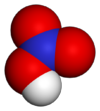Nitric acid
| Nitric acid | |
|---|---|
 
| |
| General | |
| Systematic name | Nitric acid |
| Other names |
Aqua fortis |
| Molecular formula | HNO3 |
| SMILES | O[N+](=O)[O-] |
| Molar mass | Molar mass::63.01 g/mol |
| Appearance | Clear, colorless liquid |
| CAS number | CAS number::7697-37-2 |
| Properties | |
| Density | [[Density::1.51 g/cm3]] |
| Solubility in water | miscible |
| Melting point | Melting point::-42 °C |
| Boiling point | Boiling point::83 °C |
| Acidity (pKa) | -2 |
| Viscosity | ? cP at ? °C cP at ?°C |
| Structure | |
| Molecular shape | trigonal planar |
| Dipole moment | ? D D |
| Hazards | |
| MSDS | External MSDS |
| EU classification | Oxidant (O) Corrosive (C) |
| NFPA 704 (≤40%) | |
| NFPA 704 (> 40%) | |
| NFPA 704 (fuming) | |
| RTECS number | QU5775000 |
| Related compounds | |
| Related compounds | Nitrous acid Dinitrogen pentoxide |
| Except where noted otherwise, data are given for materials in their standard state (at 25 °C, 100 kPa) Disclaimer and references | |
Nitric acid is an acid which means that it has acidic properties. Those properties include a pH below 7, a bitter taste and a sometimes violent reaction with other metals. Nitric acids chemical formula is HNO3. Nitric acid is a clear colorless liquid that is very corrosive. Nitric acid is usually used in the making of explosives and fireworks. Nitric acid can also be used to create different salts which are called nitrates all of which are soluble in water. Several of them are also used in the making of explosives.
Properties
Nitric Acid is a clear, colorless liquid with a chemical equation of HNO3. It will turn into white crystals if it is at -42°C, and it will boil at 83°C. If it is allowed to boil it or if it is left at room temperature it will decompose a little. When it decomposes it starts to form Nitrogen Dioxide which is NO2. You can tell if it has started to decompose if it shows traces of yellow or red in the otherwise clear liquid. Also if it is pure Nitric Acid it will give off white fumes while if there is Nitrogen Dioxide in it the fumes would be red or possible yellow.
Nitric acid is an acid which means that it can form different types of salts when it reacts with alkalis, carbonates or even basic oxides. Since it is an oxidizing agent it will react with many organic materials and it can even cause explosions.
Occurrences
Nitric acid is not a naturally occurring substance, it is created in a laboratory. The most common way that it is made is by taking nitrogen dioxide and mixing it with water but this must be done in the presence of air. They can make several different "types" of nitric acid by making its concentration stronger or weaker. When making nitric acid in the laboratory they must always use glass instead of rubber or cork this is because nitric acid will eat away at those specific materials.
Nitric acid can also be made by mixing together sodium nitrate and sulfuric acid. They also have made it by using the catalytic oxidation of ammonia.
Uses
Nitric acid is usually used in fertilizer and explosives. When it is used in explosives the nitric acid reacts with toluene and sulfuric acid and forms trinitrotoluene which is also known as TNT.
Nitric acid is also used by jewelers. They use it to test if a piece of jewelry is gold or platinum because those metals will not dissolve in the nitric acid when it is mixed with hydrochloric acid.
If it is treated with ammonia it will turn into one of the most important parts of fertilizer which is ammonium nitrate. Ammonium nitrate is also used when they make explosives. Nitric acid is used also when people are making the detonating parts of explosives. The manufacturers treat silver azide, mercury fulminate, and lead azide with nitric acid to get the detonators.
References
- Nitric Acid Wikipedia
- Properties of Nitric Acid Properties and classification of nitric acid
- Uses of Nitric AcidUses of Nitric Acid
- Chemical Industry Nitric AcidUses of nitric acid
- Nitric acidPlatinum today
| ||||||||||||||



